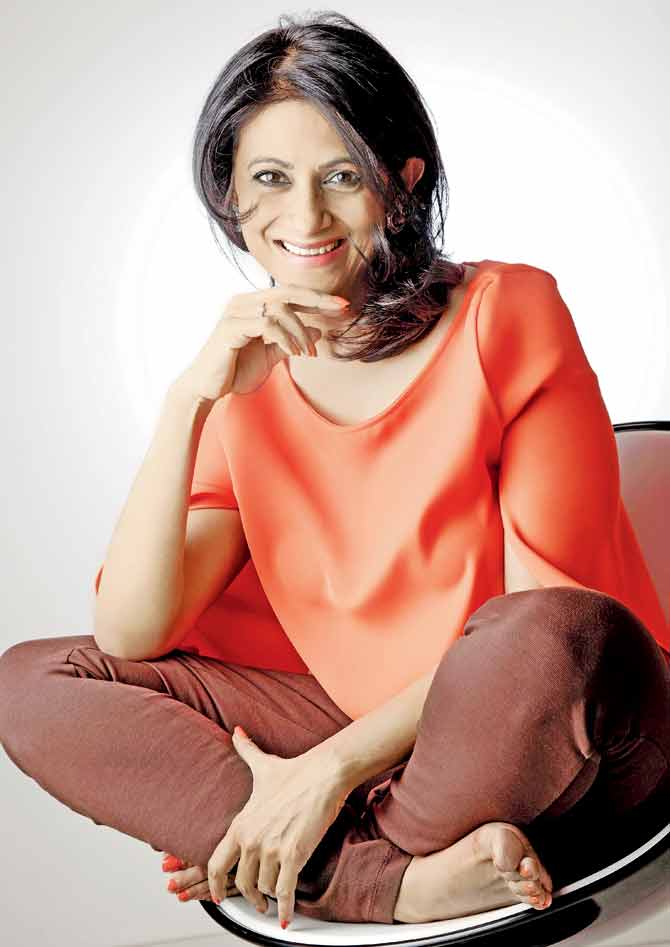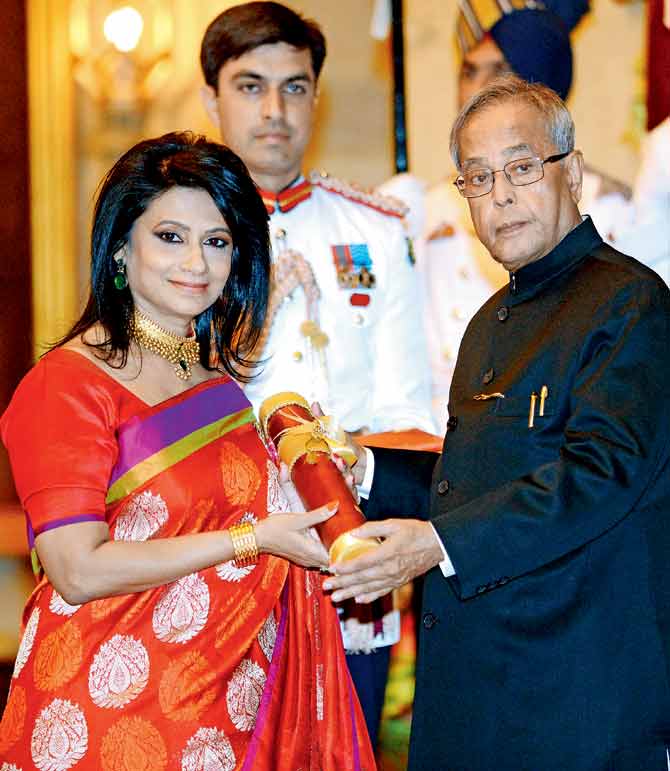As India Design Forum returns to Mumbai, Rajshree Pathy, its powear-woman, talks on why the nation needs to think design (and stop labelling her as a ‘sugar-baroness’)

Pathy receiving the Padma Shree award from President Pranab Mukherjee at The Presidential Palace in New Delhi on April 5, 2013.
Over a call in the wee hours of the night, if there is such a paradox as a straightforward rhetorician, it has to be Rajshree Pathy. Laughing and claiming to be 15 when the subject of her age is brought up, Pathy is both warm and brisk, qualities that the Padma Shri awardee and the managing director of Rajshree Group of Companies loans to the India Design Forum (IDF). IDF is the alter ego to the entrepreneur who runs a company that produces white sugar, organic manure, bio-products and power in Coimbatore. The story of her truncated desire to become an architect is now part of the Pathy legend.
ADVERTISEMENT

Rajshree Pathy. MD, Rajshree Group
In 2012, IDF, co-founded by Pathy and daughter Aishwarya, debuted in New Delhi, followed by a 2013 Mumbai edition; after a financial sabbatical of two years, IDF 2016 will hit public and indie venues in Mumbai as part of Make in India Week from February 13.

Pathy receiving the Padma Shree award from President Pranab Mukherjee at The Presidential Palace in New Delhi on April 5, 2013. Pic/AFP
Having hosted speakers like luxury footwear designer Christian Louboutin and architect Rahul Mehrotra in the past, the event pulls in both the glam and the brawn, perhaps a little more of the latter this time given its collaboration with Make in India and its investor guests. But design, Pathy is clear, is the soul of manufacturing. Edited excerpts from the interview:
Q. You are now in Coimbatore just days before the IDF is set to begin in Mumbai. How are you managing it?
A. Coimbatore, where my factory is located, is my hub. We have a team of eight to manage the back-office and my daughter [and co-founder of IDF] Aishwarya is also here, having recently become a mother. She felt that Coimbatore would be a better place to bring up the baby. Physical presence is no more a limitation to organise an event anywhere in the world. So much gets done over the Internet. My iPhone is a little thing that gets a large volume of work done. It shows the power of good design.
Q. IDF is returning after a hiatus of two years. What were the reasons for this gap?
A. We had to take a break since the event was so large in 2012 and 2013. IDF is an exorbitant expenditure, which is privately funded. Right from accommodation for speakers to venues, it costs a lot of money.
Q. IDF 2016 has a design trail and a conference. Why have you chosen Mumbai again as the venue? Why aren’t you venturing into New Delhi as you had in 2012?
A. In 2013, when we had held Design Matters at the National Centre for Performing Arts (NCPA), we found the enthusiasm in Mumbai overwhelming. Delhi is the place for art, but Mumbai is the place for design. There are urban pockets full of design activity; institutions, such as Bhau Daji Lad Museum, IIT-B and JSW that actively support design, are great influencers of society. Besides, the proximity to Pune, which is known for its automotive design, and the National Institute of Design (NID) in Ahmedabad, also helps.
Q. We often tend to club the words art and design. How would you distinguish the two?
A. Art is a personal expression, almost selfish if I may add. Design, on the other hand, is a solution-provider that can turn craft into a contemporary product. It is about functionality; it intervenes in products and manufacturing processes.
If you had to ask me what the best example of Indian design is, I would say it’s a thali; it is quintessentially Indian. Design has to be relevant to a culture. In the Indian context, where we don’t use forks and knives, the thali is totally relevant. We can’t import something from Italy and make it work here. Moreover, the thali is used by both the wealthy and the rural villager. That’s design — it is democratic. Art can’t do that.
Q. This time around, IDF has collaborated with Make in India. Who approached whom?
A. Make in India approached us in mid-November. We were scheduled to organise the event in Bengaluru a little later in the year. IDF is unique as a design platform and we address several design verticals, such as automotive and product design, and the convergence of these with each other. At every IDF conference, we have policymakers and ministers, because it is important they are part of this process. We are excited that design is included as a mainstream activity at the Make in India Week.
Q. Does this mean that IDF and design were not “mainstream” earlier?
A. Well, people talk usually about the manufacturing sector, but not enough about design. The problem is that people think design is a product. A physical product is only incidental to design. Design is not a thing; it is a way of thinking. How can design be used to create a service or a product? With IDF, along side student exhibitions by the National Institute of Design (NID), at Make in India, design has arrived.
Q. You mentioned that Bengaluru was supposed to be the venue for IDF this time. We would have thought so too — that Bengaluru, with its vibrant start-up culture, is an obvious choice.
A. Bengaluru is, of course, great for innovation, and we are looking to broad-base IDF in the future. We do want to have it happening every alternative year, as well as have smaller programmes in tier II cities, to provide exposure and opportunity.
Q. Among Indian designers, who do you think is doing a good work?
A. Satyendra Pakhale, Nipa Doshi and artists Thukral and Tagra come to my mind. Thukral and Tagra have been working with Meissen porcelain and with ETRO to make handbags. Others that I can also think of are Little Shilpa, Gunjan Gupta and Nappa Dori.
Q. The story of how you wanted to study architecture, but were signed up by your mother to continue the family business is now pretty well-established. So, apart from the IDF, how do you personally persist with your interest in art and design?
A. I build all my spaces and even design my own furniture. I am a complete modernist and like minimalism. My houses, be it in New Delhi or Coimbatore, use concrete, steel and natural material. I like functionality over opulence. So, my furniture is simple and inexpensive. I even built the company’s factory 25 years ago. Sugar factories, if you have ever visited one, are conventionally like a tunnel — planned to have sugarcane go in on one end, and have sugar come out from the other. That requires more manpower and monitoring. I changed it to a square model, rather than a linear one, to bring in a central monitoring; architects, technicians and machine suppliers didn’t agree initially. But finally, I was able to get it done. Coimbatore, surrounded by the Nilgiris Hills, has a healing energy that keeps me emotionally and physically stable and fulfilled. Every year, I visit the Isha Yoga Center...
Q. Sadhguru Jaggi Vasudev from Isha is the first speaker at IDF this time.
A. Yes. His talk is called Design for Life and will also include a presentation on the architecture of the Isha Center. He has designed everything at Isha himself. The centre’s elliptical Dhynalinga dome is the largest built in the last 100 years.
Q. How do you manage everything? You run the IDF, you are chairperson of the Confederation of Indian Industry (CII)-South, and you are a sugar baroness.
A. I laugh at the label ‘sugar baroness’! It makes me sound redundant. I live in the real world rather than royalty living life in silk cushions. My work is in rural Tamil Nadu and Telengana with sugarcane farmers, and with democratic design, not luxury.
 Subscribe today by clicking the link and stay updated with the latest news!" Click here!
Subscribe today by clicking the link and stay updated with the latest news!" Click here!








